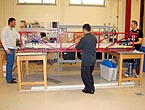Recent News
UNM Engineering team wins ASEE best paper for work on first-year engineering course
July 17, 2025
New director will enhance interdisciplinary engineering learning opportunities
July 2, 2025
Final SIRI cohort visits UNM campus
June 30, 2025
Perfetti receives ANS Landis Engineering Achievement Award
June 26, 2025
News Archives
Trying to Sense the Small Changes that Signal Big Trouble in Bridges
January 26, 2010
 No one is more interested in the tiny changes in Bridge #7937 on I-40 near Tucumcari than the UNM Department of Civil Engineering. Over the summer Professor Mahmoud Taha and his research team installed sensors to monitor reactions the bridge has as trucks travel across it. Strain gauges look at how the bridge is responding to heavy loads. Accelerometers measure acceleration and both are connected to a Smart Data Acquisition system that sends the information, along with temperature readings back to the UNM structures lab. At the lab a scale model of the bridge is monitored by the research team.
No one is more interested in the tiny changes in Bridge #7937 on I-40 near Tucumcari than the UNM Department of Civil Engineering. Over the summer Professor Mahmoud Taha and his research team installed sensors to monitor reactions the bridge has as trucks travel across it. Strain gauges look at how the bridge is responding to heavy loads. Accelerometers measure acceleration and both are connected to a Smart Data Acquisition system that sends the information, along with temperature readings back to the UNM structures lab. At the lab a scale model of the bridge is monitored by the research team.
Photo: Graduate students with model bridge in structures lab.
"There is no way to measure damage directly, but we can monitor the structure as it reacts to repeated loads and try to find the point at which the structure begins to react differently,” Taha says.
Artificial intelligence algorithms developed by Taha and his research team at UNM are used to pattern the bridge behavior and recognize its deviation from the normal performance as damage takes place.
“Integrating these technologies can prevent catastrophes like the one which happened in Minneapolis in 2007,” he says, “and that is the focus of our research.”
This bridge is of particular interest to the New Mexico Department of Transportation because it needs strengthening to meet the Federal Highway Administration (FHWA) standards. The UNM team designed, built and installed the monitoring system and software needed to monitor the bridge. The project was funded by FHWA. The new system operates on solar cells and communicates all its data wirelessly.
Taha says, “This project shows that with such advanced technology we can provide sustainable monitoring of infrastructure anywhere in the world.”
